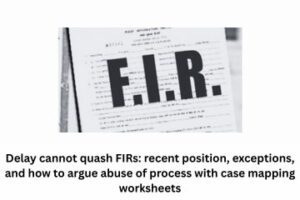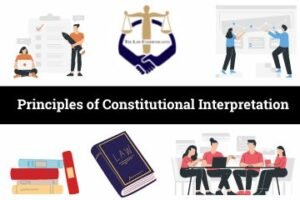Judicial Activism in Environmental Protection
Written by Akarsh Sharma
The Judicial Activism‘ made by the Temples of Justice through coercive sanctions of the judicial process for the noble cause of protection of the environment and prevention of pollution, has remarkably brought cheers to the millions of silent victims of industrial pollution and environmental disaster. The Supreme Court and the High Courts of India have established a new jurisprudence in India’s onward march towards sustainable development. It discusses how certain unused provisions of the law are being developed as a significant tool in the protection of the environment and highlights the vigilance of the Judiciary.
The major contribution of the Supreme Court to human rights jurisprudence has been enlarging the scope of Article 21 relating to the right to life and including within its ambit the right to a safe and pollution-free environment. A vast body of case law has been developed favouring the right to a clean and healthy environment as a fundamental right within the meaning of the right to life under Article 21 of the Constitution of India. This step by the Supreme Court of India has been hailed by some scholars as the most inventive step towards the fundamental rights of the citizens.
This chapter brings out the powers of the judiciary and discusses through case law and the significant decisions handed down by the Supreme Court in favour of a right to the environment and the principles established for the protection of the environment and human rights of the people affected by environmental degradation. Despite the positive role played by the judiciary in pronouncing a number of landmark judgments in pollution-related cases and interpreting the right to a healthy environment within the meaning of the right to life, the chapter highlights two important cases, namely, the Sardar Sarovar Project (SSP) and the Bhopal Gas Disaster case in which its approach was contradictory to its activist stand. It fell short of meeting the public expectation of providing relief to the communities affected by large infrastructural development projects and to the victims of mass disasters. It did not consider the long-term cumulative effects of mass disasters that adversely impact not only the present generations but future generations as well.
India incorporated a number of basic human rights as fundamental rights that are sacrosanct in the Constitution such as freedom of expression, right to life and liberty, equality before law and protection against discriminatory laws. In addition, largely drawn from the Universal Declaration of Human Rights, it incorporated certain. Directive Principles of State Policy (DPSP) are principles that are fundamental for the governance of the country. The purpose of the Fundamental Rights, on the one hand, and the Directive Principles, on the other, is complementary.
In order to ensure that the promises made by the Constitution would not remain merely on paper, the Constitution-makers provided for an independent judiciary. The Judiciary is invested with the power to ensure that all organs of the Constitution act within the respective constitutional limits. The Supreme Court is at the apex of the legal hierarchy. The Supreme Court has the power to issue writs under its original jurisdiction for infringement of Fundamental Rights guaranteed by the Constitution. It has Appellate jurisdiction in certain civil and criminal matters. The Supreme Court acts as a watchdog against violations of Fundamental Rights guaranteed under the Constitution. Laws made by the legislature, contrary to the provisions of the Constitution can be struck down by the Supreme Court or the High Courts. The validity of government decisions can be challenged before the higher judiciary and writs of mandamus are available for enforcing the State to comply with its obligations. It has the power to review any law passed by the legislature. Judicial review of the executive action, legislation and judicial and quasi-judicial orders is recognised as part of the basic structure of the Constitution.
The Supreme Court is the final interpreter of the Constitution- a power that cannot be taken away even by an amendment of the Constitution. The law declared by the Supreme Court is binding on all authorities. The Supreme Court gives due importance to international conventions and norms for construing domestic laws, more so, when there is no inconsistency between them and there is a void in domestic law. For example, in the absence of a law on sexual harassment of women in the workplace, the Supreme Court relied upon international human rights law, namely, the Convention on All Forms of Discrimination against Women (CEDAW) to lay down the guidelines. It held that, In cases involving a violation of human rights, the country must forever remain alive to the international instruments and conventions and apply the same to a given case when there is no inconsistency between the international norms and the domestic law occupying the field. Modern environmental law has its roots in the common law relating to nuisance.
A nuisance is an unlawful interference with the plaintiff’s use or enjoyment of land. A plaintiff must, therefore, prove some injury to his enjoyment of property and his own interest in that property. An occupier of the property can sue for nuisance. A nuisance would include offensive smells, noise, air pollution and water pollution. There are two kinds of nuisance – public and private. A public nuisance injures, annoys or interferes with the quality of life of a class of persons who come within its neighbourhood. It is an unreasonable interference with the general rights of the public. It is both a tort and a crime.
The remedies for a public nuisance are; (1) a criminal prosecution for the offence of causing a public nuisance (Section 268 of the Indian Penal Code, 1860), (2) A criminal proceeding before a magistrate for removing a public nuisance (Sections 133-144 of the Cr.P.C., 1973), (3) a civil action by the Advocate General or by two or more members of the public with permission of the court, for a declaration, injunction or both (Section 91 of the CPC, 1908).
A private nuisance is a substantial and unreasonable interference with the use and enjoyment of land. The reasonableness of the defendant’s conduct is the central question in the nuisance cases. An action for private nuisance may seek injunctive relief as well as damages. In cases of a continuing cause of action, such as pollution of a stream of factory wastes or smoke emissions from a chimney, the proper course is to sue for an injunction. Repeated actions for damages may be brought to recover the loss sustained up to the date of the court’s decree, but future losses, which are contingent on the continuance of the wrong, are not usually awarded. Damages offer poor relief since the plaintiff would be compelled to bring successive actions. Ordinarily, therefore, courts grant the plaintiff an injunction where a nuisance exists or is threatened, unless he or she is guilty of improper conduct or delay.
A common law action for negligence may be brought to prevent environmental pollution. In an action for negligence, the plaintiff must show that (1) the defendant was under a duty to take reasonable care to avoid the damage complained of, (2) there was a breach of that duty, and (3) the breach of duty caused the damage. The degree of care required in a particular case depends on the surrounding circumstances and varies according to the risk involved and the magnitude of the prospective injury.
An act of negligence may also constitute a nuisance if it unlawfully interferes with the enjoyment of another‘s right to land. Similarly, it may also amount to a breach of the rule of strict liability in Rylands Vs. Fletcher, if the negligent act allows the escape of anything dangerous that the defendant has brought on the land. The first significant judgment in which the Apex Court held that a responsible municipal council cannot run away from the principal duty by pleading financial liability was Ratlam Municipality v. Vardhichand.
The Supreme Court gave directions to the municipalities, the state administration and statutory bodies to perform their duty in the matter of sanitation, health and environment. It directed the removal of the nuisance. A similar direction was given in the case of LK Koolwal v. State of Rajasthan wherein the petitioner had approached the court in the matter relating to the prevalence of an acute sanitation problem in Jaipur asking the court to issue directions to the State to perform its obligatory duties.
The Supreme Court while directing the municipality to remove the dirt, and filth from the city, observed that the maintenance of health, preservation of sanitation and environment is the statutory duty of the municipality. The Court observed that the health risks posed by the lack of sanitation and the resultant pollution will adversely affect the life of citizens as it would amount to slow poisoning. This would, if not checked, reduce the life of the citizens because of the hazards that would be created, thereby violating Article 21 of the Constitution which is a fundamental right.
In the Indian Council for Enviro Legal Action v. Union of India relating to the notification of the coastal zone regulations, the court held that the enforcement agencies are under an obligation to strictly enforce environmental laws; In the Delhi Garbage case the Court held that the Government agencies may not plead nonavailability of funds, inadequacy of staff or other insufficiencies to justify the nonperformance of their obligations to strictly enforce environmental laws.
The case came up before the court for non-performance of statutory duty by the municipal authorities regarding the collection, removal and disposal of garbage and other wastes in the city of Delhi, the Court held that the authorities entrusted with the work of pollution control have been totally remiss in the discharge of their duties under the law and that they cannot absolve themselves of their duties on the pretext of financial and other limitations like inefficiency of staff members. The Court issued directions to the Delhi Administration to perform its duties. In order to ensure that the improvements would actually take place, it also directed the Central Pollution Control Board (CPCB), a statutory body, to organise a comprehensive inspection of the follow-up steps that were being taken every two months and to report the results to the Supreme Court.
Referring to Article 51-A (g) regarding the fundamental duties under the Constitution, the Court stated that it was the duty of the Central Government to direct all educational institutions throughout India to teach lessons in school for at least one hour per week relating to the protection of the natural environment, including forests, rivers and wildlife, and to distribute textbooks on the subject free of cost to educational institutions. In the case of air pollution in Delhi, the Court ruled that it was the duty of the Government to ensure that the air was not contaminated by vehicular pollution.
In the case of damage to the Taj Mahal from air pollutants from the Mathura Refinery, the court directed the creation of a Taj trapezium to regulate activities in relation to air pollution. The Court asked the Government to take steps to undertake clean-up operations to restore the whiteness of the marble of the Taj Mahal. In the aforementioned public interest matters, the Supreme Court, in giving directions to the government was acting in consonance with fulfilling its constitutional obligations.




